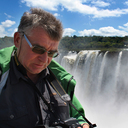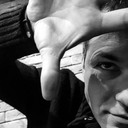0 Likes
محمد حسین عماد
شعاع
۱۴ آذر تا ۱۲ دی ۱۳۹۹
گالری آریانا پلاس با همکاری گالری اثر
گالری آریانا پلاس به همراه گالری اثر آخرین حجم های محمد حسین عماد را با عنوان «شعاع» در طبقه ی اول گالری آریانا پلاس نمایش می دهند.
در این نمایش، ۹ اثر از جنس چوب و ترکیب چوب و فایبرگلاس که همگی در سه سال گذشته خلق شده اند، در معرض دید قرار گرفته-اند.
محمد حسین عماد در ادامه ی روند خلاقانه اش که بسیار شهودی و در عین حال به طور غیر مستقیم مبتنی بر تفکرات و جهان بینیش است، بار دیگر بر تضاد بین پر و خالی، برون و درون، خلاء و ماده، روشنایی و تاریکی و به طور کلی تضاد موجود در اشیاء می-پردازد. او این بار اما جست و جوگرانه، در پی مبدأ است، که از دیده پنهان، و برخلاف ماده، عاری از هر گونه تضاد است.
همان طور که از عنوان نمایش پیدا است، عماد در این مجموعه بر «شعاع» یا همان ردیوس که به لاتین به معنای شعاع نور نیز هست تاکید داشته و بر مفهوم فیزیکی و فلسفی آن و نه لزومن معنای هندسیش تکیه می کند. او می گوید: « در دایره، شعاع، مرکز را به محیط وصل می کند، مثل نوری که به همه جا می تابد. پس شعاع نور با شعاع دایره هماهنگ است.» از نظر او انسان همواره به دنبال منشأ است و با نگاه به مبدأ، معنا را جست و جو می کند.
محمد حسین عماد در پی کشف مبدأ، با زبان زیبایی شناسانه ی خود حجم هایش را می سازد که در همه ، جهان بینی اش مشهود است. آن چه میان آثار به نمایش درآمده مشترک است مفهوم فعال بودن «تهی» است که از پیش نیز در آثار او هویدا بود. تمرکز و کار بر معماری درون چوب به نحوی که بتواند نور را کنترل کند از اساس کار او بوده و زاویه ی دید انسان و مشخصات فیزیکیش - که در نهایت بیننده ی آن چه او خلق می کند است – نیز تاثیری بسزا در شکل و ارایه ی آثار او دارند.
محمد حسین عماد در سال ۱۳۳۶ در اراک متولد شد و نزدیک به سه دهه است که در تهران کار و زندگی می کند. در این مدت او نمایش های انفرادی و گروهی بیشماری در ایران و خارج از ایران داشته و جوایز بسیاری را از آن خود کرده است. همچنین برخی از آثار او در تهران و چند شهر دیگر ایران در فضای عمومی نصب شده اند. او همچنین در سال های فعالیت حرفه ای خود مدرس دانشگاه هنر تهران بوده و شاگردان بسیاری را در زمینه ی مجسمه سازی بطور خصوصی و دانشگاهی تربیت کرده است.
Mohammad-Hossein Emad
Radius
4 Dec. 2020 – 1 Jan. 2021
Ariana Plus Gallery in collaboration with Assar Art Gallery
Ariana Plus Gallery in collaboration with Assar Art Gallery presents the latest sculptures by Mohammad-Hossein Emad titled Radius.
Three years in the making, all 9 sculptures on display are made of wood and fiberglass.
In continuation of his intuitive creative practice, which is indirectly based on his ideology, Emad has once again laid emphasis on the contrast between full and empty, outside and inside, material and vacuum, lightness and darkness and the divergence between objects in general. This time, however, he seeks the source, which is unseen and lacks contrast unlike substance.
As implied by the title of the exhibition, Emad focuses on radius with a look on its Latin roots also meaning ray, and accentuates its physical and philosophical connotation and not its geometrical sense. He says: “Radius is a line segment from circle’s center to its parameter exactly like the ray of light that casts light on everything, therefore, ray of light is in harmony with circles’ radii.” In his opinion, humans are always in search of the source and this is how they quest for meaning.
In order to discover the source, Emad creates his sculptures with his aesthetic language that resonates his philosophy. What all exhibited works have in common, is the activity of “void” again, which can be traced in his entire body of work from the past. Focusing and working on the architecture of the inside of the wood in a way to be able to control the light is the essence of his practice. In addition, the physical specifications of his viewers and the angle from which he wants them to view the work have great impact on the form and presentation of his sculptures.
Mohammad-Hossein Emad was born in 1957 in Arak, Iran. He has been living and working in Tehran for the past three decades. Throughout this time, he has had numerous solo and group exhibitions in Iran and abroad and he has won many awards. Also, his work has been installed in public spaces in Tehran and several other cities of Iran. Emad has also been a lecturer at Tehran’s University of Art and educated many sculptors.
نمایشگاه آثار " محمد حسین عماد" با عنوان " شعاع " آذر و دی 1399 گالری آریانا پلاس
...





Overview and HistoryTehran is the capital of Iran and the largest city in the Middle East, with a population of fifteen million people living under the peaks of the Alborz mountain range.Although archaeological evidence places human activity around Tehran back into the years 6000BC, the city was not mentioned in any writings until much later, in the thirteenth century. It's a relatively new city by Iranian standards.But Tehran was a well-known village in the ninth century. It grew rapidly when its neighboring city, Rhages, was destroyed by Mongolian raiders. Many people fled to Tehran.In the seventeenth century Tehran became home to the rulers of the Safavid Dynasty. This is the period when the wall around the city was first constructed. Tehran became the capital of Iran in 1795 and amazingly fast growth followed over the next two hundred years.The recent history of Tehran saw construction of apartment complexes and wide avenues in place of the old Persian gardens, to the detriment of the city's cultural history.The city at present is laid out in two general parts. Northern Tehran is more cosmopolitan and expensive, southern Tehran is cheaper and gets the name "downtown."Getting ThereMehrabad airport is the original one which is currently in the process of being replaced by Imam Khomeini International Airport. The new one is farther away from the city but it now receives all the international traffic, so allow an extra hour to get there or back.TransportationTehran driving can be a wild free-for-all like some South American cities, so get ready for shared taxis, confusing bus routes and a brand new shiny metro system to make it all better. To be fair, there is a great highway system here.The metro has four lines, tickets cost 2000IR, and they have segregated cars. The women-only carriages are the last two at the end, FYI.Taxis come in two flavors, shared and private. Private taxis are more expensive but easier to manage for the visiting traveler. Tehran has a mean rush hour starting at seven AM and lasting until 8PM in its evening version. Solution? Motorcycle taxis! They cut through the traffic and any spare nerves you might have left.People and CultureMore than sixty percent of Tehranis were born outside of the city, making it as ethnically and linguistically diverse as the country itself. Tehran is the most secular and liberal city in Iran and as such it attracts students from all over the country.Things to do, RecommendationsTake the metro to the Tehran Bazaar at the stop "Panzda Gordad". There you can find anything and everything -- shoes, clothes, food, gold, machines and more. Just for the sight of it alone you should take a trip there.If you like being outside, go to Darband and drink tea in a traditional setting. Tehranis love a good picnic and there are plenty of parks to enjoy. Try Mellat park on a friday (fridays are public holidays), or maybe Park Daneshjou, Saaii or Jamshidieh.Remember to go upstairs and have a look around, always always always! The Azadi Tower should fit the bill; it was constructed to commemorate the 2500th anniversary of the Persian Empire.Tehran is also full of museums such as:the Contemporary Art Museumthe Abghine Musuem (glass works)the 19th century Golestan Royal Palace museumthe museum of carpets (!!!)Reza Abbasi Museum of extraordinary miniaturesand most stunning of all,the Crown Jewels Museum which holds the largest pink diamond in the world and many other jaw-dropping jewels.Text by Steve Smith.